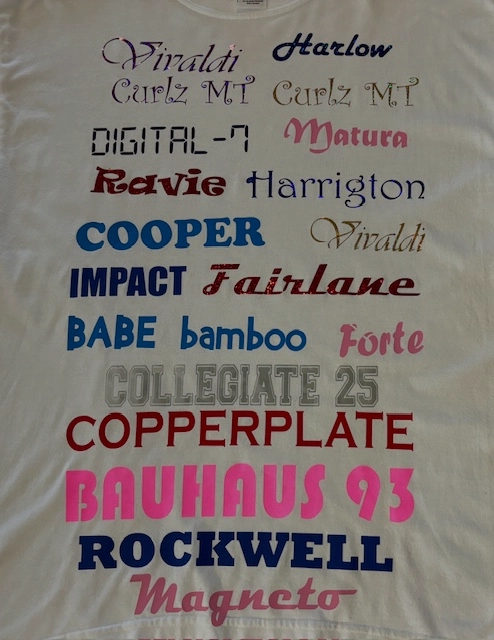The Art of Personalized Embroidery: Unlocking the Secrets to Creating Distinct and Unforgettable Styles
Needlework, a craft soaked in practice and virtuosity, holds within its detailed stitches the power to change textile right into a canvas of one-of-a-kind expression. The keys to creating custom embroidery designs that astound the eye and leave a lasting impression hinge on a fragile equilibrium of strategy, creative thinking, and focus to information. As we dig into the world of customized embroidery, we reveal the nuanced interaction in between thread selection, stitch intricacy, and layout customization that raises a mere garment to a masterpiece. Join us on a trip via the art of custom-made needlework as we decipher the mysteries behind crafting truly unforgettable and distinct productions.
Selecting the Right Needlework Threads
When choosing needlework threads, what crucial variables should you think about to make certain the best results for your custom-made designs? The choice of embroidery string is crucial in identifying the last end result of your stitched design. One of the main factors to consider is the product of the string. Different materials such as cotton, polyester, rayon, and silk use differing degrees of sheen, longevity, and texture. It is vital to pick a string product that enhances the textile you are embroidering on and aligns with the preferred appearance of the layout.
Moreover, the weight or density of the string plays a significant role in the look of the needlework. Thicker strings can include measurement and appearance to your layout, while finer strings are excellent for detailed information and tiny message. In addition, considering the shade fastness and washability of the string is important to guarantee that your customized designs maintain their top quality and vibrancy gradually. By very carefully examining these elements and choosing top quality threads that fulfill your details needs, you can improve the visual appeal and longevity of your stitched developments.
Checking Out Various Stitch Methods
To look into the realm of 'Checking out Various Stitch Methods', one must comprehend the intricacies and subtleties that each sewing technique offers the art of embroidery. Various stitch strategies not only include aesthetic rate of interest yet also add to the overall structure and measurement of the design. One prominent stitch strategy is the satin stitch, which involves carefully stuffed parallel stitches to create a smooth and shiny surface area, perfect for completing forms and developing bold details.
On the various other hand, the backstitch is a versatile technique usually used for describing and including great information. It involves stitching backwards to produce a strong line of needlework. Additionally, the French knot stitch adds a tactile aspect to styles, excellent for developing textured accents like flower centers or decorative touches.
Checking out various stitch strategies permits embroiderers to have fun with light, darkness, and depth within their designs, raising the visual charm and creative top quality of their needlework tasks. By understanding numerous sewing approaches, one can unlock endless possibilities for producing distinct and unforgettable custom-made needlework items.
Incorporating Personalized Layout Aspects
Having actually checked out the intricacies of various stitch strategies such as the satin stitch, backstitch, and French knot, the focus currently moves view towards including individualized design components in custom-made embroidery tasks. Customized design components play an important role in making needlework jobs absolutely special and memorable.
An additional way to include individualized layout aspects is by consisting of signs or motifs that hold special meaning to the recipient or show their passions and character. For example, integrating a favorite flower, pet, or hobby-related symbol can make the needlework design a lot more purposeful and individualized. Additionally, selecting shades that reverberate with the recipient or align with the designated theme can even more improve the customization of the embroidery job.
Understanding the Art of Color Sychronisation
One trick aspect of color sychronisation is comprehending shade theory. This consists of knowing exactly how various colors engage with each various other, the emotions they communicate, and just how they can be combined to produce aesthetically appealing styles. By using shade theory principles, embroiderers can produce unified color combinations that improve the total look of the style.
In addition, taking notice of comparison is crucial in color sychronisation. Making use of contrasting shades can help specific aspects of the layout pop, boost legibility, and create a visually dynamic needlework item. By understanding the art of shade coordination, embroiderers can raise their layouts and develop remarkable pieces that resonate with clients and audiences alike.
Enhancing Structure With Advanced Needlework Stitches

French knots, for instance, are perfect for including tiny, elevated dots to your design, simulating the appearance of beads or developing a textured surface area. Bullion knots, on the various other hand, can womens tailored suits be made use of to create twisted, ropelike aspects that include an extravagant feeling to the embroidery. Seed stitching includes little, scattered stitches that can fill out locations with a speckled texture, while turkey work produces fluffy, dimensional accents similar to animal hair or vegetation. Explore these innovative needlework stitches allows you to push the limits of typical embroidery and create really special and aesthetically enticing textures in your designs.
Verdict
Finally, the art of custom needlework entails a combination of selecting the best threads, exploring various stitch methods, integrating tailored layout components, understanding color coordination, and boosting structure with advanced stitches. By recognizing and carrying out these crucial elements, embroiderers can develop distinct and remarkable layouts that showcase their creative thinking and skill. Needlework lovers can open the tricks to developing stunning and bespoke items that stick out and leave a long lasting perception.